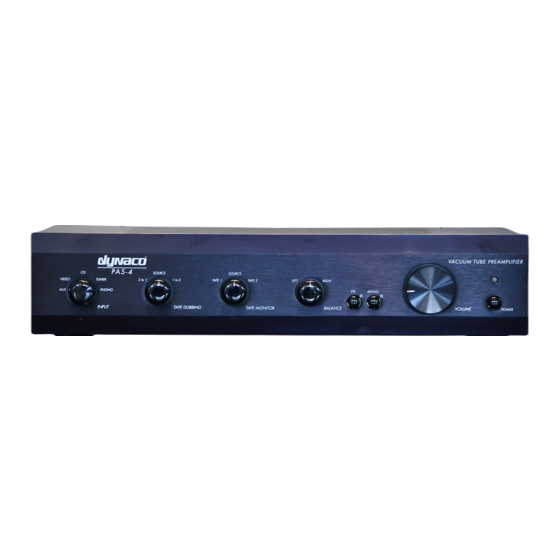DYNACO PAS-4 Manual do Proprietário - Página 7
Procurar online ou descarregar pdf Manual do Proprietário para Amplificador DYNACO PAS-4. DYNACO PAS-4 15 páginas. Vacuum tube preamplifier
Também para DYNACO PAS-4: Manual do Proprietário (16 páginas)

Tube Replacement
CAUTION: Before replacing tubes on your PAS-4 ensure the AC power cord is un- plugged from its AC
(wall) outlet (or that the AC power cord is unplugged from the back of the unit) and wait for
three minutes to allow the high voltage power supply to discharge. Gloves may be worn
when changing tubes. Never touch live circuit elements in vacuum tube equipment because
lethal voltages are present when these are turned on.
The tubes in your PAS-4 could provide 5,000 to 10,000 hours of use. We recomend that these tubes be
replaced after no more than 3,000 hours of use to avoid the slightly "muffled" sound or slight bass "roll-
off" which can begin to occur with old tubes.
Microphonics (various "pinging" or "howling" sounds) is due to a tube being overly sensitive to physical
vibrations. To avoid it, do not operate vacuum tube equipment on top of vibrating surfaces (such as
loudspeakers). But if a tube is so sensitive that just having the preamplfier turned on causes the
microphonic sounds, the tube will have to be replaced. It can happen that a tube becomes microphonic
with age or that it is only microphonic before it warms up (or only after it warms up).
The most common type of problem in tube preamplifiers is excessive noise caused by a worn or faulty
tube. The characteristics of this noise can vary a great deal. If a noise problem occurs with your PAS-4,
99% of the time it will be due to a faulty tube
The most likely source of tube noise in the PAS-4 is the phono section first stage tubes V1 (left channel)
or V4 (right channel). Less likely, but to be suspected next, would be the phono stage second stage
tubes V2 (left) or V5 (right). If the undesirable noise increases as you turn up the volume control, the
faulty tube is likely to be one of the phono section tubes. The line stage tubes are V3 (left) and V6 (right).
(Refer to the tube numbers printed adjacent to pin #1 of each tube on the printed circuit board.)
Note:
When removing a tube, grasp the tube socket with one hand and the tube with the other hand.
Move the tube (slightly) from side to side while pulling outward.
An easy way to determine if a tube in any particular position is causing un-desirable noise is to
swap the suspected tube with its counterpart in the opposite channel. If the noise jumps to the
other channel, the tube you suspected is indeed faulty.
The most certain method for confirming a faulty tube
is by substitution of a known good tube.
7
